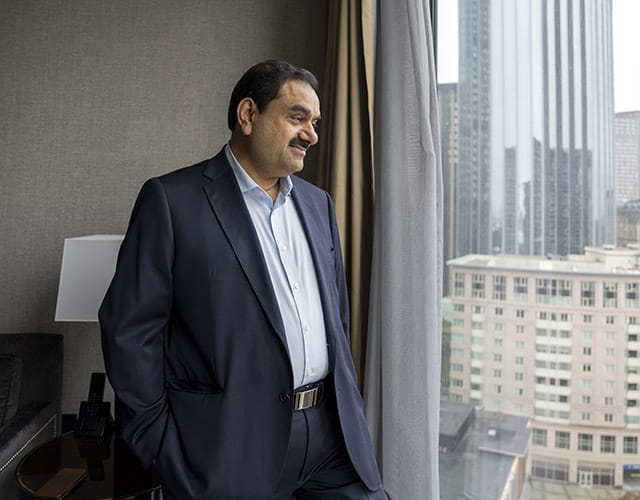The younger son of Mukesh Ambani, India’s richest man, wed his fiancee in Mumbai on July 12, the finale of a months-long extravaganza that signaled the arrival of the unapologetic Indian billionaire on the global stage — and introduced the world to the country’s Gilded Age.
For much of the year, the festivities surrounding the nuptials of Anant Ambani and Radhika Merchant, the daughter of a fellow business tycoon, have grabbed eyeballs for their lavish displays of wealth. Millions have been spent on diamonds and emeralds the size of credit cards, on haute couture saris, on wedding invitations made of silver and gold.
Billionaire businesspeople, Bollywood stars, models and politicians were among the more than 1,200 guests at a prewedding bash in March. Bill Gates stopped by. Rihanna performed. In May, the bride and groom-to-be threw a four-day party on a luxury cruise ship in the Mediterranean; Merchant told Vogue India they couldn’t find a land venue big enough to host all their guests.
Jay Gatsby would have been awed.
The spectacle has served as an invitation to peek inside India’s uppermost echelons, where a few individuals and families have amassed astounding fortunes in recent years. Buoyed by booming growth and a cheerleading government, the number and wealth of Indian billionaires has soared. They are overlords of the Indian economy, running the phone networks that connect millions of people, the hospitals that treat them, the supermarkets where they shop and the high-rises in which many live.
A Lot of Money, in the Hands of the Few
In 2000, India had nine billionaires, according to Oxfam. Now India has 200 billionaires, who collectively hold around $1 trillion in wealth, according to Forbes — nearly a quarter of the country’s 2023 gross domestic product.
Their dizzying rise is stark in a land where many live below or just around the poverty line, mirroring the extreme inequality of America’s Gilded Age, when robber barons flaunted their jewels amid extreme destitution.
Kavil Ramachandran, a professor of entrepreneurship at the Indian School of Business, said there were more billionaires with fatter wallets because India has sustained a high growth rate for more than two decades. That’s created a deep domestic market for goods and services and pushed Indian companies to pursue new businesses, pairing opportunity with ambition.
“It’s a consequence of rapid growth and entrepreneurialism,” Ramachandran said.
In 2002, Radhakishan Damani spotted the opportunity for an Indian supermarket and launched his first store in Powai, a suburb of Mumbai. More than two decades later, his company Avenue Supermarts runs one of the country’s most popular supermarket chains, DMart. Damani, who has a net worth of $17 billion, is sometimes called India’s “retail king.”
A recent study about wealth and inequality in India subtitled “The Rise of the Billionaire Raj” found that the total wealth of billionaires has steadily increased from under 5% of national income in the 1990s to more than a fifth in 2022.
“All of this suggests that at least the very rich seem to be doing very well in recent years,” the authors wrote.
India’s Opening Set Off Breakneck Growth
India has come a long way from its socialist origins. Until 1990, the country operated under strict government supervision and protectionist policies. Companies could only run after procuring multiple permits and licenses from the government, leading to the name “License Raj” — a play on the term British Raj, which referred to colonial rule.
Once India opened up its economy after a series of reforms, some domestic companies embraced the logic of free markets while remaining family-run and tightly controlled, diversifying into new businesses.
In the 2000s, India’s software and services boom — for a time, the country was nicknamed the world’s “back office” — created a slew of new billionaires. Azim Premji successfully transformed Wipro from a hydrogenated cooking fat company into an IT giant, becoming one of India’s first tech billionaires. Fellow tech billionaire Nandan Nilekani co-founded Infosys and helped create Aadhar, a unique identification system for Indian citizens that is somewhat similar to a Social Security card.
Gautam Adani, whose conglomerate the Adani Group is India’s biggest ports operator, has ridden the country’s shipping, infrastructure and energy boom to build a net worth of more than $80 billion.
Adani’s rise has matched that of Prime Minister Narendra Modi, with whom he shares close ties and whose ambitions for India have unleashed a construction frenzy. Everywhere, there are new bridges, highways, tunnels and high-speed rail tracks — and Adani’s company is at the center of many of them.
The Ambanis Are the First Family of Indian Capitalism.
Ambani, whose $115 billion fortune also makes him Asia’s richest man, has long sat atop India’s explosive growth in wealth. Reliance Industries, the giant conglomerate founded by his father that is the source of much of his family’s fortune, has sometimes served as a proxy for India’s economic rise.
Its businesses include one of the world’s largest oil refineries, India’s biggest mobile phone network, television and entertainment ventures and a popular chain of grocery stores.
Many Indians see in Ambani’s staggering rise in stature and wealth a version of the India they want: a country that doesn’t make a play for attention but demands it. Some even feel pride that his son’s wedding has attracted such global attention. To them, India’s poverty is a predictable fact; such opulence is not.
“Based on the level of the Ambanis’ wealth, the wedding is perfect,” said Mani Mohan Parmar, a 64-year-old resident from Mumbai.
“Even the common man here in India spends more than his capacity on a wedding,” Parmar said. “So it’s nothing too much if we talk about Ambani. He has so much money due to God’s grace, so why shouldn’t he spend it by his choice?”
Some Question the Showy Displays of Wealth
Rashmi Venkatesan, who teaches human rights law and popular culture at the National Law School of India University, found the “consciously explicit public nature” of the Ambani wedding peculiar.
To Venkatesan, the celebration was about more than the wealthy getting wealthier; she was bothered by what she called the “valorization” of this kind of wealth.
It’s not just the mind-boggling rise of billionaire wealth that is new, but also the way that wealth has created a new kind of royalty in a country well acquainted with maharajahs.
Like yesteryear’s royal families, today’s billionaires are increasingly keeping their wealth within their class — either through dynastic succession or by marriage. Each of Ambani’s three children are heading up three different lines of the Reliance business.
In 2018, Ambani’s daughter Isha married Anand Piramal, the son of billionaire Ajay Piramal, who runs one of India’s pharmaceutical giants. His son Anant now has married Radhika, the 29-year-old daughter of Viren and Shaila Merchant, the multimillionaire founders of a health care company on whose board she sits.
c.2024 The New York Times Company. This article originally appeared in The New York Times.







